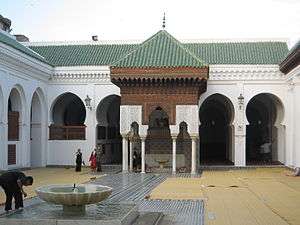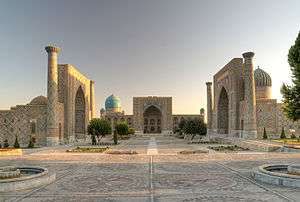List of Islamic seminaries

This is a list of Islamic seminaries throughout history, including the operational, historical, defunct or converted ones. This list includes mainly madrasa in the Western context, which refers to the specific type of religious school or college for the study of the Islamic religion and Islamic educations, though this may not be the only subject studied. It also includes sectarian or regional variants which have distinct characteristics and traditions, though serves the identical purposes as seminary, namely Hawza of Shi'a Islam, Nezamiyeh in the medieval Persia, Darul Uloom which has roots in South Asia, Qawmi in Bangladesh, pesantren in Indonesia, and pondok in Malaysia and Southern Thailand. This list does not include institutions which are not religious seminaries, but have an Islamic identity or charter, or devoted to sciences and arts usually associated with Islamic culture and history, namely Islamic University.
List of Islamic seminaries
The listings are in alphabetical order by country.
Bangladesh
- Al-Jamiah Al-Islamiah Obaidia Nanupur, Chittagong
- Al-Jamiah Al-Islamiah Patiya, Chittagong
- Al-Jamiatul Ahlia Darul Ulum Moinul Islam, Chittagong
- Al-Jamiatul Arabiatul Islamiah, Ziri, Chittagong
- Al-Jamiatul Islamiah Azizul Uloom Babunagar, Chittagong
- Al-Jamiatul Islamiah Qasemul Uloom Charia, Chittagong
- Al-Markazul Islami As-Salafi, Nawdapara
- Islamic Research Center Bangladesh, Bashundhara
- Jamia Darul Ma'arif Al-Islamia, Chittagong
- Jamia Luthfia Anwarul Uloom Hamidnagar, Molovibazar
- Jamia Madania Angura Mohammadpur, Sylhet[3]
- Jamia Qurania Arabia Lalbagh, Dhakka
- Jamia Rahmania Arabia Dhaka, Dhakka
- Jamia Shari'ah Malibag, Dhaka, Dhakka
- Jamia Tawakkulia Renga Madrasah, Sylhet
- Jamiah Islamiah Hussainia Gohorpur, Sylhet
- Jamiah Islamiah Yunusia Brahmanbaria, Brahmanbaria
- Jamiatul Uloom Al-Islamia Lalkhan Bazar, Chittagong
- Sheikh Zakariyyah Islamic Research Center, Dhakka
Cyprus
Egypt
- Al-Azhar Madrasa, Cairo
- Emir Qurqumas Complex, Cairo
- Madrasa of Jamal al-Din, Cairo
- Madrassa of Al-Nasir Muhammad, Cairo
- Qalawun complex, Cairo
- Salihiyya Madrasa, Cairo
- Madrasa of Sarghatmish, Cairo
- Mosque and Khanqah of Shaykhu, Cairo
- Sultan Al-Ghuri Complex, Cairo
- Mosque-Madrassa of Sultan Hassan, Cairo
India
Indonesia
- SMK Nahdlatul Ulama Balikpapan
- Pondok Pesantren Gading Mangu Perak Jombang, Jombang
- Pondok Pesantren Al Manshurin Metro Lampung, Bandar Lampung
- Pondok Pesantren Mellenium Alfina, East Java
- Pondok Pesantren Minhaajurrosyidiin Jakarta, Jakarta
- Pondok Pesantren Walibarokah Burengan Banjaran Kediri, Kediri
- Pondok Pesantren Waria Al-Fatah, Yogyakarta
- Pondok Modern Darussalam Gontor, Ponorogo
Iran
Iraq
Mali
- Djinguereber Madrasa, Timbuktu
- Sidi Yahya Madrasa, Timbuktu
- Sankore Madrasah, Timbuktu
Morocco
Pakistan
- Ahsan-Ul-Uloom, Karachi
- Darul Uloom Haqqania, Akora Khattak
- Darul 'Uloom Karachi, Karachi
- Jamia Binoria, Karachi
- Jamia Khair-ul-Madaris, Multan
- Jamia Hafsa, Islamabad
- Jamia Uloom-ul-Islamia, Karachi
Palestine
Saudi Arabia
Singapore
- Madrasah Al-Irsyad Al-Islamiah, Singapore
- Madrasah Aljunied Al-Islamiah, Singapore
- Madrasah Al-Maarif Al-Islamiah, Singapore
- Madrasah Alsagoff Al-Arabiah, Singapore
- Madrasah Al-Arabiah Al-Islamiah, Singapore
- Madrasah Wak Tanjong Al-Islamiah, Singapore
Spain
Syria
- Al-Adiliyah Madrasa, Damascus
- Al-Ahmadiyah Madrasa, Aleppo
- Al-Fathiyah Madrasa, Damascus
- Al-Firdaws Madrasa, Aleppo
- Al-Halawiyah Madrasa, Aleppo
- Al-Kameliyah Madrasa, Aleppo
- Al-Mujahidiyah Madrasa, Damascus
- Al-Muqaddamiyah Madrasa, Aleppo
- Nur al-Din Madrasa, Damascus
- Al-Qilijiyah Madrasa, Damascus
- Al-Rukniyah Madrasa, Damascus
- Al-Sahiba Madrasa, Damascus
- Al-Salimiyah Madrasa, Damascus
- Al-Shadbakhtiyah Madrasa, Aleppo
- Al-Shamiyah al-Kubra Madrasa, Damascus
- Al-Sharafiyah Madrasa, Aleppo
- Al-Sibaiyah Madrasa, Damascus
- Al-Sultaniyah Madrasa, Aleppo
- Al-Turantaiyah Madrasa, Aleppo
- Al-Uthmaniyah Madrasa, Aleppo
- Al-Zahiriyah Library, Damascus
- Al-Zahiriyah Madrasa, Aleppo
Tunisia
- Madrasa Al Habibia Al Kubra, Tunis
- Madrasa Al Habibia Al Sughra, Tunis
- Madrasa Al Husseiniya Al Kubra, Tunis
- Madrasa Al Husseiniya Al Sughra, Tunis
- Madrasa Al Jassoussia, Tunis
- Madrasa Khaldounia, Tunis
- Madrasa Asfouria, Tunis
- Madrasa Andaloussiya, Tunis
- Madrasa Caid Mourad, Tunis
- Madrasa Ibn Tafargine, Tunis
- Madrasa Bir Lahjar, Tunis
- Madrasa El Jedid, Tunis
- Madrasa Ech Chamaiya, Tunis
- Madrasa El Achouria, Tunis
- Madrasa El Bachia, Tunis
- Madrasa El Bechiria, Tunis
- Madrasa El Kacemia, Tunis
- Madrasa El Maghribia, Tunis
- Madrasa El Mountaciriya, Tunis
- Madrasa El Mettichia, Tunis
- Madrasa El Tawfikia, Tunis
- Madrasa El Unqiya, Tunis
- Madrasa El Yusefiya, Tunis
- Madrasa Ennakhla, Tunis
- Madrasa Ez-Zitouna, Tunis
- Madrasa Hamzia, Tunis
- Madrasa Hamzia, Tunis
- Madrasa Mouradiyya, Tunis
- Madrasa Salhia, Tunis
- Madrasa Slimania, Tunis
- Madrasa Saheb Ettabaâ, Tunis
- Madrasa of Zawiya El Bokria, Tunis
Turkey
- Büyük Aga Medrese, Amasya
- Caferağa Medresseh, Istanbul
- Gök Medrese, Tokat
- Gök Medrese, Sivas
- Hatuniye Külliyesi, Tokat
- Hatuniye Medresesi, Karaman
- Ince Minaret Medrese, Konya
- Karatay Madrasa, Konya
- Kasımiye Medrese, Mardin
- Kubat Pasha Madrasa, Tarsus
- Medrese of Mehmet Şakir Paşa, Mustafapaşa
- Pervane Medrese, Sinop
- Sahn-ı Seman Medrese, Istanbul
- Seyyid Battal Gazi Complex, Seyitgazi
- Şifaiye Medrese, Sivas
- Sırçalı Medrese, Konya
- Yakutiye Medrese, Erzurum
- Vacidiye Medrese, Kütahya
United Kingdom
- Darul Uloom, Birmingham
- Darul Uloom, Bolton
- Darul Uloom, London
- Darul Uloom, Blackburn, Lancashire
United States
Ukraine
Uzbekistan
- Abulkasym Madrassah, Tashkent
- Dorut Tilavat, Bukhara
- Mir-i Arab Madrassah, Bukhara
- Sher-Dor Madrasah, Samarkand
- Tilya-Kori Madrasah, Samarkand
- Ulugh Beg Madrasa, Samarkand
Yemen
List of oldest Islamic seminaries
| Year | Current Location | Name | Other notes |
|---|---|---|---|
| 859 | University of Al Quaraouiyine | Founded by Fatima al-Fihri, originally as a mosque. In addition to a place for worship, the mosque soon developed into a place for religious instruction and political discussion, gradually extending its education to a broad range of subjects, particularly the natural sciences. Al-Karaouine played, in medieval times, a leading role in the cultural exchange and transfer of knowledge between Muslims and Europeans. Pioneer scholars such as Ibn Maimun (Maimonides), (1135–1204), Al-Idrissi (d.1166 AD), Ibn al-Arabi (1165-1240 AD), Ibn Khaldun (1332-1395 AD), Ibn al-Khatib, Al-Bitruji (Alpetragius), Ibn Hirzihim, and Al-Wazzan were all connected with the university either as students or lecturers. Among Christian scholars visiting Al-Karaouine were the Belgian Nicolas Cleynaerts and the Dutchman Golius. Among the subjects taught, alongside the Qur'an and Fiqh (Islamic jurisprudence), are grammar, rhetoric, logic, medicine, mathematics, astronomy, chemistry, history, geography and music. It is considered the oldest university in the world by some scholars,[4][5] and the oldest continuously-operating degree-granting institution in the world by the Guinness Book Of Records,[6] although some dispute this claim.[7] | |
| 970-972 | Al-Azhar University | Founded by the Fatimid dynasty of Egypt, this university served as a center for Arabic literature and Sunni Islamic learning. The college (Jami'ah) had faculties in Islamic law and jurisprudence, Arabic grammar, Astronomy, Islamic philosophy, and Logic. The Al-Azhar is considered by some as the world's second oldest surviving degree-granting institute. According to the Encyclopedia of Islam, Al-Azhar was a religious university, a madrasa and center of higher learning.[8]
In the 1950s, Al-Azhar underwent significant change, with new regulations and reform resulting in an expanded role.[9] In 1961 it became a modern university when many modern secular faculties were added, such as medicine, engineering and agriculture. | |
| 1065 | Nizamiyya | Nizamiyya: This series of universities was established by Khwaja Nizam al-Mulk in the eleventh century in what is now present-day Iran. The most celebrated of all the Nizamiyya schools is Al-Nizamiyya of Baghdad, established in 1065 in Dhu'l Qa'da and that remains operational in Isfahan. But, this was just one of many Nizamiyyah schools — others were located in Nishapur, Amul, Mosul, Herat, Damascus, and Basra. The Nizamiyya schools served as a model for future universities in the region, and al-Mulk often is seen as responsible for a new era of brilliance which caused his schools to eclipse all other contemporary learning institutions. |
See also
| Wikimedia Commons has media related to Islamic schools. |
- List of Islamic universities and colleges
- List of Islamic educational institutions
References
- ↑ Oldest University
- ↑ "Medina of Fez". UNESCO World Heritage Centre. UNESCO. Retrieved 7 April 2016.
- ↑ "About Us". Jamia Madania Angura Muhammadpur.
- ↑ Esposito, John (2003). The Oxford Dictionary of Islam. Oxford University Press. p. 328. ISBN 0-19-512559-2.
- ↑ Kettani, M. Ali. Engineering Education in the Arab World. Middle East Journal, 1974, 28(4):441.
- ↑ The Guinness Book Of Records, Published 1998, ISBN 0-553-57895-2, p. 242
- ↑ Some sources claim that University of Bologna is the oldest in the world.
- Paul L. Gaston (2010). The Challenge of Bologna. p. 18. ISBN 1-57922-366-4. External link in
|title=(help)
- Paul L. Gaston (2010). The Challenge of Bologna. p. 18. ISBN 1-57922-366-4. External link in
- ↑ Jomier, J. "al- Azhar (al-Ḏj̲āmiʿ al-Azhar)." Encyclopaedia of Islam, Second Edition. Edited by: P. Bearman , Th. Bianquis , C.E. Bosworth , E. van Donzel and W.P. Heinrichs. Brill, 2010, retrieved 20 March 2010:
This great mosque, the 'brilliant one'...is one of the principal mosques of present-day Cairo. This seat of learning...regained all its activity—Sunnī from now on—during the reign of Sultan Baybars...Al-Azhar at the beginning of the 19th century could well have been called a religious university; what it was not was a complete university giving instruction in those modern disciplines essential to the awakening of the country.
- ↑ Skovgaard-Petersen, Jakob. "al-Azhar, modern period." Encyclopaedia of Islam, THREE. Edited by: Gudrun Krämer, Denis Matringe, John Nawas and Everett Rowson. Brill, 2010, retrieved 20 March 2010:
Al-Azhar, the historic centre of higher Islamic learning in Cairo, has undergone significant change since the late 19th century, with new regulations and reforms resulting in an expanded role for the university. 1. From madrasa to university
